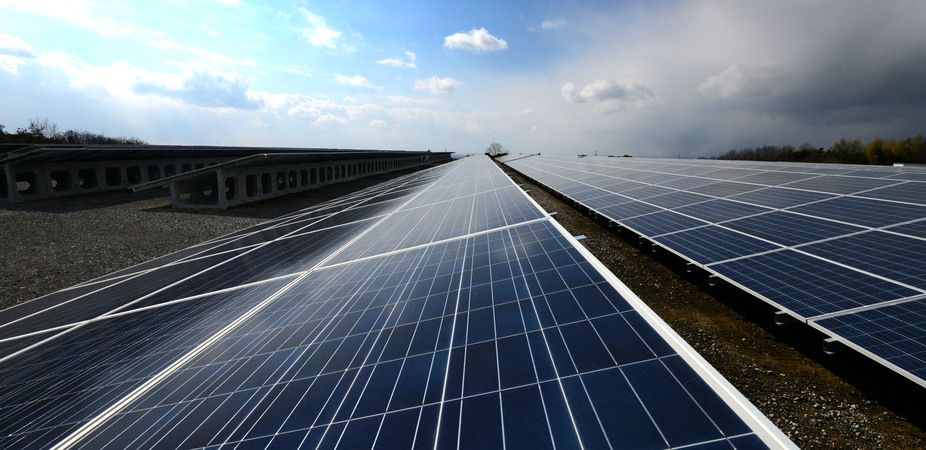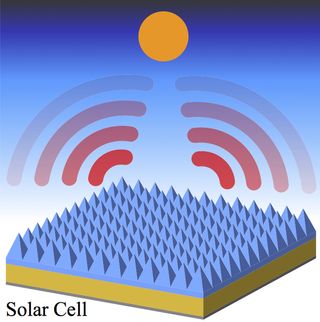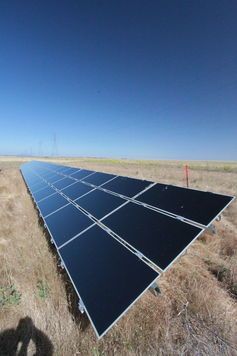
More Efficient, Durable Solar Cells are Possible Thanks to Glass (Op-Ed)

This article was originally published at The Conversation. The publication contributed the article to Live Science's Expert Voices: Op-Ed & Insights.
Self-cooling, longer lasting and more efficient solar cells are within reach simply by adding a thin layer of glass.
A paper published today in the online journal Optica outlines a possible solution for better access to solar energy.
Solar cells work by converting solar radiation into energy. Through this process, a certain amount of energy loss is expected.
But a surprising amount of energy is lost through solar cells overheating. This limits the cell’s ability to produce electricity and reduces its lifespan.
Beating the heat
The research team from Stanford University in California found that when a thin layer of silica glass embedded with tiny cone and pyramid structures is placed over the top of silicon solar cells, the operating temperature of the cells dropped dramatically.
Led by Professor of Electrical Engineering Shanhui Fan, the researchers discovered that this layer of glass redirects unwanted heat through the atmosphere and into space.
Sign up for the Live Science daily newsletter now
Get the world’s most fascinating discoveries delivered straight to your inbox.
By eliminating excess infrared radiation, the solar cells stay cool and are more efficient at converting solar rays into energy.

Lead author on the paper, PhD physics candidate Linxiao Zhu, said that the discovery could lead to developing more cost effective solar panels, making them a better renewable energy alternative.
“Lowering the temperature of solar cells leads to higher operating efficiency,” said Zhu.
“Moreover, a lower operating temperature for solar cells leads to a significantly longer lifespan, thereby reducing the levelised cost of energy from a system.”
Reducing wasted energy
According to the paper, the upper limit of power conversion efficiency for a single silicon cell is around 33.7%. As the cell heats up, that efficiency goes down – about half a per cent for every one degree increase in temperature.
The costs of active methods for cooling solar cells – such as ventilation or liquid coolants – outweigh the benefits. So up until now the loss of efficiency through overheating has not been resolved.

This passive method works by utilising the different wavelengths of solar radiation. Visible light in the spectrum is best at carrying energy, while infrared carries more heat.
The researchers calculated that by “turning away” the infrared radiation using silica glass, heat goes down without negatively effecting the amount of visible light the solar cell can absorb.
“We came up with an optimal design consisting of microscale silica pyramids,” said Professor Fan.
“[This] both maximises the cooling power via the radiative cooling mechanism, while remaining transparent at wavelengths of solar radiation.”
Australian National University’s Andrew Blakers said that while the authors of this study have a sound theoretical basis, this model is unlikely to be feasible in the real world.
“Unfortunately, the comparisons in the paper are between special structures and bare solar cells, rather than with encapsulated cells [and] bare solar cells are never deployed in the field,” said Bakers, who is the Director of the Centre for Sustainable Energy Systems (CECS) at ANU.
“The standard glass superstrate has many functions including toughness, scratch resistance, structural strength, resistance to moisture ingress, adhesion to EVA/silicone.
“The glass superstrate must be foregone because it causes too much parasitic absorption of thermal radiation - it would have to be replaced by a substrate to make the module self-supporting.”
Associate Professor Ben Powell from the University of Queensland said that while this approach is an exciting possibility, the cost could outweigh the benefits.
“If it can’t be made cheaply enough then the extra electricity gained from the efficiency gains and the saved cost replacing solar cells won’t pay for the coating – in which case no one will be interested in using it,” said the physicist.
“It’s a very elegant and promising idea, but there is a long way to go before you find this on your roof.”
In spite of this, the paper’s authors are confident that future development is possible. According to Linxiao Zhu the next step is applying this research to practical applications.
“We validated this design via extremely accurate numerical methods and are now working to experimentally demonstrate the first prototypes,” he said.
This article was originally published on The Conversation. Read the original article. Follow all of the Expert Voices issues and debates — and become part of the discussion — on Facebook, Twitter and Google +. The views expressed are those of the author and do not necessarily reflect the views of the publisher. This version of the article was originally published on Live Science.












